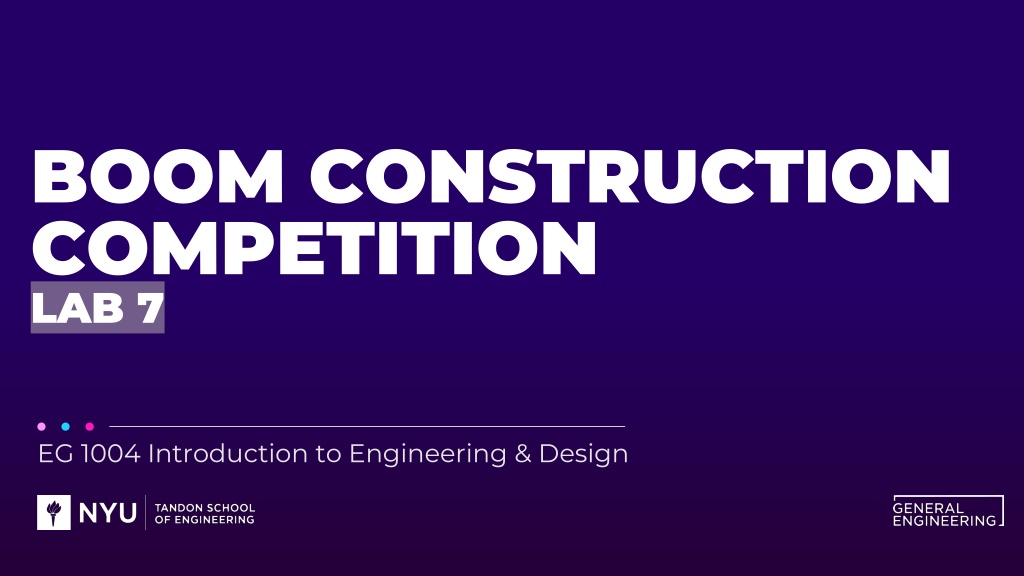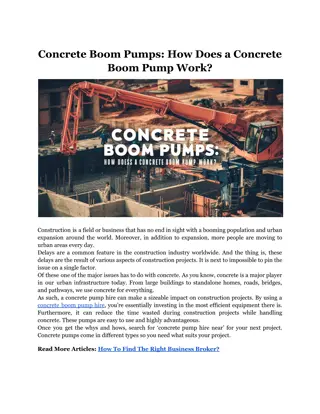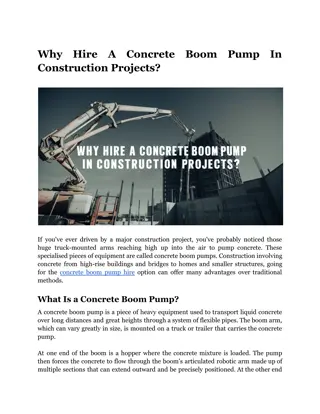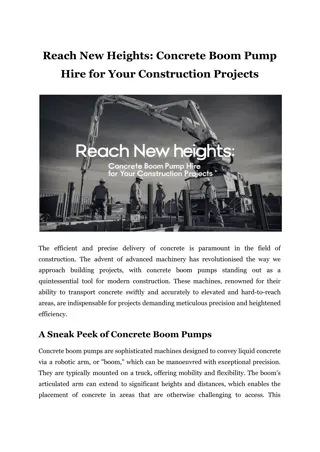BOOM CONSTRUCTION COMPETITION LAB 7
Explore the world of engineering and design through the challenge of creating a lightweight boom capable of withstanding significant loads with minimal deflection. Gain insights into stress, strain, material properties, and competition dynamics as you construct, test, and compete with your boom design. Learn about boom lifts, cantilever bridges, stress-strain curves, and more in this hands-on engineering experience.
Download Presentation

Please find below an Image/Link to download the presentation.
The content on the website is provided AS IS for your information and personal use only. It may not be sold, licensed, or shared on other websites without obtaining consent from the author.If you encounter any issues during the download, it is possible that the publisher has removed the file from their server.
You are allowed to download the files provided on this website for personal or commercial use, subject to the condition that they are used lawfully. All files are the property of their respective owners.
The content on the website is provided AS IS for your information and personal use only. It may not be sold, licensed, or shared on other websites without obtaining consent from the author.
E N D
Presentation Transcript
BOOM CONSTRUCTION COMPETITION LAB 7 EG 1004 Introduction to Engineering & Design
OVERVIEW o Objective o Background Information o Materials o Procedure o Competition Rules o IDBE Implementation o Assignment o Closing Figure 1: Cable-Stayed (Cantilever) Bridge
OBJECTIVE Design lightweight boom to hold significant load and minimally deflect Consider material properties when designing a boom Stress and strain Construct and test boom Enter boom into competition to obtain highest competition ratio
BACKGROUND INFORMATION Boom Lifts and moves heavy objects much heavier than the boom Examples Construction cranes Cantilever bridges Swing bridges Figure 2: Tower Crane Courtesy of Philadelphia Magazine
BACKGROUND INFORMATION Fixed Support Stress Strain External force acting on an object per unit cross-sectional area Measure of deformation resulting from an applied force Cross-Sectional Area of Bar (A) Lo Stress (?) = ? Strain (?) = ? ? ?0 L F F = applied force A = cross-sectional area L = change in length Lo= original length
BACKGROUND INFORMATION UTS Stress-strain curve Key points/regions Elastic limit Ultimate tensile strength (UTS) Fracture stress Elastic region {E} Plastic region {P} {P} {E} Stress (s) Elastic Limit Fracture Stress Strain (e)
BACKGROUND INFORMATION Elastic Limit UTS Point where the material becomes permanently deformed {P} Ultimate Tensile Strength (UTS) {E} Stress (s) Elastic Limit Greatest amount of stress a material can withstand Fracture Stress Fracture Stress Point where the material fails Strain (e)
BACKGROUND INFORMATION UTS Elastic Region {E} {P} Material will return to its original shape when load is removed {E} Stress (s) Elastic Limit Plastic Region {P} Fracture Stress Material will permanently deform even after load is removed Strain (e)
EXAMPLE DEMONSTRATION UTS {P} {E} Stress (s) Fracture Stress Strain (e)
EXAMPLE DEMONSTRATION UTS {P} {E} Stress (s) Fracture Stress Strain (e)
EXAMPLE DEMONSTRATION UTS {P} {E} Stress (s) Fracture Stress Strain (e)
MATERIALS Thin dowels (0.8 cm diameter) Thick dowels (1.1 cm diameter) 3D-printed dowels connectors Cellophane tape String
PROCEDURE Design a boom to obtain the highest competition equation ??? ?? ???? ? + 30 [?]+???? ????? [?] 60 [?] ??????????? ???????? = (???? ?????)2+ 1.5 [?] Consider the basic mass ratio ???? ????? =???? ????????? [?] ???? ???? [?]
PROCEDURE Assess materials to design the boom Construct and test the boom
PROCEDURE Figure 4: Setup for Competition
COMPETITION RULES Boom must be anchored to the white plastic anchorage Boom must be anchored in less than two minutes Boom may not be fixed to anything besides the anchorage Boom must extend at least 1.5 meters horizontally from the edge of the anchorage Boom basic weight ratio must be greater than 1 A team can use any number of dowels, as long as their total length is less than or equal to the length of 4 uncut dowels (4 x 122 cm, or 488cm)
COMPETITION RULES Make a sketch of your design and get a TA to sign off on it Anchor time will be timed from when the TA says go to when all hands are off the boom TA will place a holder for the weights at the end of the boom The boom must start at least 0.30 m from the ground after adding 15 grams of preload TA will place weights in the holder until the boom deflects 20 cm or fails Values will be entered into a competition scoresheet which will be available on the EG1004 Website
IDBE IMPLEMENTATION Engineering Responsibility Must uphold industrial and ethical standards Risks are large and impact is widespread Cost of failure is catastrophic: human life Case Study: Tacoma Narrows Bridge Windy conditions led to bridge oscillations Design could not support the elasticity of the vibrations Catastrophic failure of the bridge No deaths Figure 5: Tacoma Narrows Bridge
ASSIGNMENT Individual lab report: Answer discussion questions in manual Include competition scoresheet results Include pictures of the boom Due at 11:59 PM the night before Lab 8 Extra credit opportunity: Can replace a lower grade on either Lab 3 or Lab 5 if this lab report grade is higher
ASSIGNMENT Team presentation: Address discussion points in manual State rules of the competition Include pictures, competition scoresheet, digital sketches Due at 11:59 PM the night before the next Recitation
CLOSING Think safety! Be careful not to poke classmates with the dowels Get a TA to help if dowels need to be sawed Have all original data signed by a TA Submit all work electronically Take pictures Clean up workstations Return the dowel connectors do not throw them away Return all unused materials to the TA



























